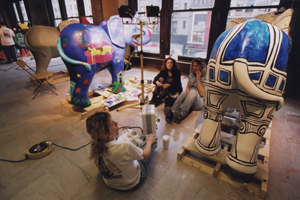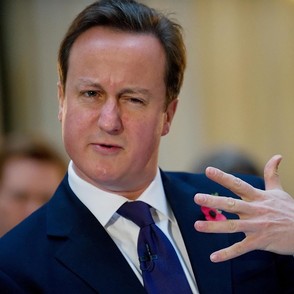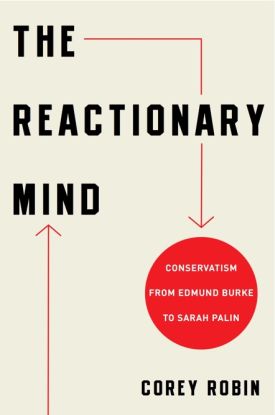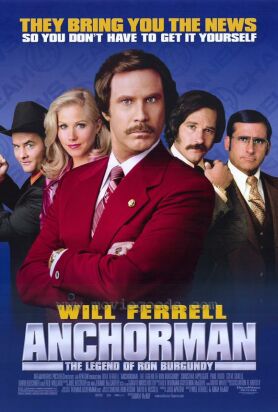Taking Ourselves Seriously
From The New CriterionThey have lately started appearing on the streets of Washington, the gaily painted, smaller than life- sized effigies of elephants and donkeys collectively known as “Party Animals” that are the latest incarnations of the kind of public art pioneered by Chicago’s cows three years ago. Actually, Zürich first came up with the idea (if it is not to dignify such a gesture to call it an idea) but, as in so many other cases, Americans have taken the lead in marketing a European concept. Since then, for instance, there have been pigs in Cincinnati and Seattle, horses in Lexington, Kentucky, buffalo in Buffalo, moose in Toronto and stylized beagles — or “Snoopies” — in St. Paul, which is the birthplace of Charles Schultz, creator of the cartoon strip “Peanuts” — to name just a few examples of that good old American can-do spirit.
But while such kitsch was merely annoying in the City of Big Shoulders and elsewhere, there is something epoch-making about its arrival in the seat of government. One senses a sort of quasi-official benediction being pronounced upon the more general Disney-fication of the culture, a final assimilation of public discourse to mere boosterism and glad-handing. Washington’s first “Party Animals” were unveiled by the First Lady, Laura Bush, and Mayor Anthony Williams. As Jacqueline Trescott wrote in the Washington Post, “When they lifted off the bright red covering, they both burst into laughter. And that’s the point: to show Washington’s secret whimsical side, to showcase its artists and to give residents and tourists the same kind of diversion that ‘Cows on Parade’ provided Chicago.”
Actually, Washington’s “whimsical side” can hardly be said to be much of a secret these days, as some of us thought recently when (according to the Wall Street Journal’s “Washington Wire” column) the House appropriations committee adjourned for three hours so that its members could attend the expert testimony being given elsewhere in the capitol by the film actress, Julia Roberts, on behalf of government funding for research on Rett Syndrome. But it is now almost the case that that studied, “whimsical” quality of buildings or artefacts — say, iconic animals dressed to attract tourists by looking like a more outlandish sort of tourists themselves — is seen as one of the hallmarks of “art.” Another is that, in addition to an apparently endless supply of “artists” prepared to play this game, it provides an opportunity for collaborative contributions by schoolchildren, cancer patients, multi-ethnic encounter groups and the like.
Of course it is true that, as was observed by Anthony Gittens, executive director of the D.C. Commission on the Arts and Humanities which organized the project, “Sometimes we in Washington tend to take ourselves a bit too seriously. . .‘Party Animals’ is an opportunity to lighten up and poke a little fun at ourselves.” But you can’t help thinking that this is a man who is fundamentally uninterested in politics, or else he would know with what regularity politicians already make themselves into figures of fun — precisely by taking themselves not a bit but a lot too seriously. Still, the witty and colorful animal figures are said to be good for tourism and “community spirit.” As the mayor put it, “Art is also important because it is about the spirit of our city, the spirit of us as people, the spirit of us as Washingtonians and, yes, the spirit of us as Americans.”
Quite what “spirit” is betokened by a herd of brightly-colored fibreglass animals is unclear, but it hardly seems to bode well for the future of the Republic, does it? The sad thing is that hizzoner is probably right. One way to look at the Party Animals is as an ironic tribute to David Riesman, who died in May and whose best-seller of the 1950s, The Lonely Crowd, did so much to give rise to Americans’ (especially young Americans’) “whimsical” side a decade later. Only then, of course, whimsicality seemed to promise an escape from the need to conform to old-fashioned and adult norms. Nowadays it has itself become a way of conforming to that spirit of dreary jollity — or ludic transgression, if you prefer — which has been enforced upon us by the combined efforts of the arts, the entertainment and the diversity industries.
Although the indignity of having the First Lady preside at the unveiling of “Party Animals” is not of the same order of magnitude as those indignities which were visited upon her predecessor, Washington’s plunge into the popular culture during the Clinton years looks to be more and more irreversible. Could it have been mere coincidence, for example, that during the same week as those cute elephants and donkeys began to appear it was revealed that Bill Clinton was negotiating for his own, Oprah-like TV talk-show? The Los Angeles Times reported that Clinton had demanded $50 million from NBC for a talk show deal, which doesn’t seem unreasonable when you consider that Oprah makes $300 million a year for CBS — and that she is giving up her show (she says) in four years’ time.
Though Clinton later denied that there were “now” any plans for such a show, or that if there were it would adopt the Oprah format, it seems to me impossible to deny that, if he were not already a TV star of sorts (wasn’t he in “That Nineties Show” on Fox?) he would not be making $250,000 per speech, or up to $15 million a year, or have a $12 million book deal with Knopf. Such are the perks of being a bona fide celebrity, and adding a talk-show to the properties controlled by Clinton Enterprises Inc. would hardly represent a major diversification of the core business. And how could it be otherwise? Though it is easy to sneer about Bill’s Big Bucks, I can’t myself lay my hand on my heart and say that, in his position (always assuming that I might ever find myself in his position) I would spurn from me all such attempts to fill my lap with gold.
Although it is hard not to agree with the Nigerian woman who said of Clinton on CNN’s “Talk Back Live” that “He is the former president of the Free World. It is very demeaning for him to want to do this,” it is also hard to plow a lone furrow, to stand out against the tendency of the times, without anything in particular to stand for. At any rate it is impossible to imagine Clinton doing it.
For, just as it had presumably already become conceivable — as it was not, for instance, in the day of Dwight Eisenhower — to ask a question of the President of the United States about his preference in underpants on national television at some point before Clinton so blithely answered it, so the national willingness to treat the former president as a slightly raffish celebrity making millions from personal appearances can hardly be added to the already-brimming charge sheet of the former president. He was never the man to stand on his dignity, even back in the days when it was supposed that he had any. Dignity is in any case incompatible with the “whimsical” spirit of America, and with the kind of bogus “sincerity” and personal authenticity demanded of politicians in a celebrity-culture like ours. It will be interesting to see how long our present president is able to hold on to what remains of his own.
If there is a culprit in this sad tale of irrevocable vulgarization it is the journalistic thirst for just this kind of factitious authenticity. What was not often recognized back in March when the media world was rocked by the news that ABC was considering dumping Ted Koppel and “Nightline” in favor of David Letterman, who was thought to have been on the point of being poached from CBS, was the extent to which Koppel and Letterman were really in the same business. Both try to put “the human side” of celebrities on display for audiences that demand to see that side of them as the price of their celebrity-worship. Koppel’s celebrities tend to be more political while Letterman’s are mostly showbiz folk, but occasionally each is prepared to trespasses on the other’s territory. True, as Howard Kurtz wrote in the Washington Post, Koppel is “more interested in Yasser Arafat than Ozzy Osbourne and doesn’t care who knows it,” but it is not exactly self-evident that more enlightenment is to be expected from the one than the other.
In fact, I would expect more of genuine informative import to come out of Dave’s encounter with Ozzy — who, for those not familiar with him, was the lead singer of a defunct pop group who now has a top-rated “reality”-type show on MTV in which he pretends to be a pop star pretending to be a family man — than Ted’s with Yasser. Both derive whatever interest they possess from the celebrity-encounter, which is designed to certify the celebrities’ human side with a bit of emotion or an anecdote of private life, but the content of Arafat’s message is bound to be something that could have been scripted for him by ABC News (or anybody else), while Osbourne seems quite likely to say something unexpected. Certainly he is more whimsical.
Not that Ted himself is incapable of whimsy. Some years ago he appeared on the Letterman show in the guise of a roller-blader — what a wild and crazy guy! — which may have had something to do with Letterman’s much-publicized reluctance to be the cause of his being thrust from his late-night perch. Anyway, when you consider that, although they attract audiences of a similar size, the demographic profile of Letterman’s is younger and so more attractive to advertisers (which is why ABC wanted him), it becomes possible to speculate that, in a few years’ time, Letterman will be Koppel. Already it is clear that they come from the same, “media,” world. Just consider this paragraph from David Margolick’s account of the contretemps, rushed into print for the June number of Vanity Fair, for which he followed Koppel to a town meeting in Queens:
Koppel is now 62 years old. Unusual in his world, he has let himself grow leathery and lined. Despite his devotion to the news, even his ABC News peers sometimes find him self-righteous, uncollegial, preachy. But when he was sitting on the stage in Queens that night, the familiar back of his famous head before me, Koppel displayed everything that has made him a television institution and, increasingly, an anachronism: his intelligence, his elegance, his empathy, his reasonableness, his patience, his wit. With the wounded and indignant and intemperate of September 11, he was simultaneously scintillating and soothing. Just as striking was everything he has never been and refuses to become, as so many in television “news” now are: belligerent, inarticulate, plastic, primitive.
There it is: yet another dispatch from the celebrity hunt — this time with the hunter as the quarry — with the breathless news that some TV or movie or political icon is authentically human. Like ourselves in fact. If proof of the fact is all that we demand of them, we demand it frequently and insatiably. Admittedly, this is Vanity Fair, but such coverage was hardly untypical of the mainstream press at the time, when authenticity was conferred by the supposed high drama of the clash of media titans. “At ABC, A Shaken News Dynasty” Howard Kurtz headlined portentously in the Washington Post.
In just six days, one of television’s most respected news divisions has been plunged into disarray. Since word leaked that executives at Disney-owned ABC were courting the CBS late- night comic for Koppel’s time slot, an impassioned debate has erupted over whether even the highest-quality broadcast news can compete against popular entertainment that delivers larger and younger audiences to advertisers.
Impassioned debate? If so it is passion like that of the Rape of the Lock, and cries out for another Pope to do it justice. As in the case of Belinda and her lock, the funniest thing about the whole funny business is that those who were at the center of it didn’t see it as funny. Referring to the much-quoted remark by an anonymous ABC executive that Koppel’s show was no longer “relevant” because of the acres of instant analysis available on the Internet, Kurtz quoted yet another anonymous executive as saying that “People would have understood the economic argument. . . The hurtful part of it is being told you’re not relevant anymore.”
There speaks modern management technique. Above all, no one must be subjected to anything “hurtful” — though of course being hurt is also the best way to demonstrate personal authenticity. But the question of whether or not Mr. Koppel’s show objectively is or is not “relevant” is secondary, at best, to that of whether or not he has been treated with the sort of respect owed to one of the great panjandrums of the journalistic “profession.” That was Koppel’s own point in the thunderous counterblast he penned in the form of an op-ed piece for the New York Times, in which he wrote with a sense of self-importance worthy of the Times itself that “it is, at best, inappropriate and, at worst, malicious to describe what my colleagues and I are doing as lacking relevance.”
Naturally, all worshippers at the shrine of journalistic professionalism agreed with him. “What’s left of broadcast television journalism is at stake now, many in the business believe,” wrote Tom Rosenstiel and Bill Kovach in the Post. Oh yes? And remind me why we should care? Do Rosenstiel and Kovach really suppose that the slender skein of seriousness — tending because of its very exiguousness to shade into the pompous and self-important — represented by Mr. Koppel’s TV show is enough to redeem for “journalism” the vast sea of vulgarity and triviality otherwise represented by the networks? They go on to insist that
What Disney executives are really arguing is that journalism is just another kind of content; that communication is communication. In other words, if people can watch Larry King at 9, or Chris Matthews’s “Hardball,” or the “O’Reilly Factor” on Fox, Ted Koppel becomes irrelevant.
But what most people understand post-9-11, which Disney does not, is that when television journalism increasingly becomes defined by talk shows, celebrity and consumer segments and soap-operatic episodes on, say, “Dateline,” a show such as “Nightline” actually becomes more relevant — because it is so rare. Inside television, “Nightline” is now an island.
Caryn James in the New York Times made a somewhat similar argument for the relevance of network news in general — on the grounds, that is, that the rare bits of seriousness appearing on or among the news shows constitute a sort of cordon sanitaire to protect the rest of their news broadcasts from unseemly juxtapositions.
Soon after midnight on Friday, when the news broke that Israeli tanks were surrounding Yasir Arafat’s compound, CNN cut into its regular program. It was a replay of that night’s “Larry King Live” with guests from the television version of “Ripley’s Believe It or Not.” Mr. King talked to a woman who survived a car crash and now has 200 metal plates in her head.
That juxtaposition of the ludicrous and the earth-shattering represents the plausible future. When dealing with hard news, networks and cable both do a solid, remarkably similar job. (Well, except for the conservative Fox News Channel, where one of its anchors, Diane Dimond, has referred to members of the United States military as “our guys” and the opinionated Geraldo Rivera is playing reporter.)
The significant gap is not between networks and cable, but between real news and the newslike substance that surrounds it, filler that is the equivalent of a cheese-food product vaguely resembling the real thing. On Monday Mr. King interviewed Madeleine Albright, then chatted with Judge Judy. Next to such a whiplash-inducing lineup, naturally the network news programs look good. In a half-hour minus commercials, there’s no time for the weirdos and the shouting confrontations that pass for news on cable.
She concludes that “What the network anchors add is a sense of authority that translates to something more than style.” What it is that is more than style she never gets round to telling us, though her mention later on of the anchormen’s “symbolic importance” suggests that what she has in mind is a sort of reassurance to their audience that the gravity of the news has been answered by the gravitas of the newsmen: don’t worry about the Middle East situation’s getting out of control, folks. We have a crack team of reporters on the scene.
I wonder if there is not also some connection between this bizarre belief in the importance of journalists and the sneer directed at Diane Dimond for referring to American troops as “our guys.” The godlike figure of the network news anchor bestrides the petty squabbles of lesser men like a colossus and cannot be seen to take sides. Or, to put it another way, all emotions are welcomed to tabloid-TV save the patriotic. It’s true that Dan Rather cried on David Letterman’s show, but that was from compassion for the victims of September 11th. His subsequent expression of a patriotic willingness to be called to the colors was thought by many to be in rather poor taste. Such are the lengths to which the superstition of journalistic “objectivity” is pursued that, when Gregg Zoroya, a reporter for USA Today, interviewed a Palestinian woman about her planned suicide bombing and subsequently refused to divulge her name to Israeli security forces, hardly anyone noticed, except for Scott Shuger in Slate and Howard Kurtz in the Washington Post — and no one made a fuss about it.
Miss James’s article, referred to above, went on to make the obligatory tour of the cable channels’ inanities, including the new “Crossfire” on CNN, which she compares to Fox’s “Celebrity Boxing.” I wonder that these critics don’t get tired of their endless laments for the convergence of news and entertainment. It’s not exactly news — in more ways than one — that cable talk shows are deliberately provoked shouting matches, or that there are a high-proportion of lightweight or gossipy stories on their news broadcasts (the networks have a lot of fluff too, she admits, “but their fluff is healthier”). For myself, I say so much the better if news is entertainment. So long as we recognize the fact, we are more likely to put things in their proper perspective and not confuse TV newsreaders and interviewers with genuinely important people — except, of course, for their shared sense of whimsy.
Discover more from James Bowman
Subscribe to get the latest posts to your email.







